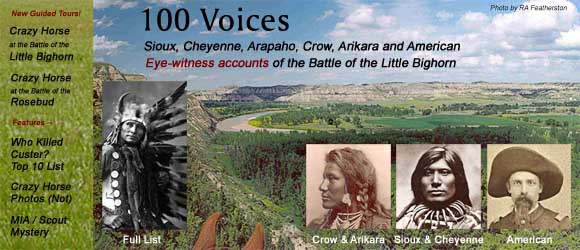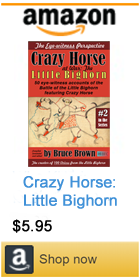|
||||||||||||
Bruce Brown's 100 Voices... Gall's Story of the Battle, #1
THE STORY OF WAR CHIEF GALL OF THE UNCPAPAS OBSERVANCE OF THE TENTH ANNIVERSARY OF THE BATTLE OF THE LITTLE BIG HORN CHIEF GALL, WHO COMMANDED THE HOSTILES, DESCRIBES THE TERRIFIC SLAUGHTER The Soldiers Killed While Fighting in Line Against a Vastly Superior Force History Corrected
was as follows: "We saw the soldiers early in the morning crossing the divide. When Reno and Custer separated, we watched them until they came down into the valley. A cry was raised that the white men soldiers were coming, and orders were given for the village to move immediately. Reno swept down so rapidly on the upper end that the Indians were forced to fight. Sitting Bull and I were at the point where Reno attacked. Sitting Bull was big medicine. The women and children were hastily moved down stream where the Cheyennes were camped. The Sioux attacked Reno, and the Cheyennes, Custer, and then all became mixed up. The women and children caught the horses for the bucks to mount them; the bucks mounted and charged back Reno and checked him, and Drove Him Into the Timber The soldiers tied their horses to trees and came out and fought on foot. As soon as Reno was beaten and driven back across the river, the whole force turned upon Custer and fought him until they destroyed him. Custer did not reach the river, but was met about half a mile up a ravine, now called Reno creek. [Note: The overwhelming eye-witness evidence demonstrates that Custer charged with his men to the banks of the Little Bighorn at Medicine Tail Coulee. Gall didn't know what happened at Medicine Tail Coulee because he wasn't there at the time; he was busy fighting Reno, and did not join the Custer fight until Custer's men had been driven back from the river. See Who Killed Custer -- The Eye-Witness Answer for more info.] They fought the soldiers and beat them back step by step until all were killed." One of Reno's officers confirms this by saying: "After we were driven back to the hill where the stand was made, there was an interval of over an hour that we had no fighting. This gave us an opportunity to shelter our horses in a ravine and partially intrench ourselves. It was probably during this interval of quiet on Reno's part that the Indians massed on Custer and annihilated him."
As Many As the Grass "The first two companies, Keogh and Calhoun, dismounted, and fought on foot. They never broke, but retired step by step until forced back to the ridge upon which all finally perished. They were shot down in.line where they stood. Keogh's company rallied by company and were all killed in a bunch." This statement seems borne out by the facts, as thirty-eight bodies of Keogh's troops were found piled in a heap. The warriors directed a special fire against the troopers who held the horses, while the others fought. As soon as a holder was killed, by moving blankets and great shouting the horses were stampeded, which made it impossible for the soldiers to escape. Afterward the soldiers fought desperately and hard, and Never Surrendered "They fought strong -- they fought in line along the ridge. As fast as the men fell the horses were herded and driven toward the squaws and old men, who gathered them up. When Reno attempted to find Custer by throwing out a skirmish line, Custer and all with him were dead." When the skirmishers reached a high point overlooking Custer's field, the Indians were galloping around and over the wounded, dying, and dead, popping bullets and arrows into them. "When Reno made his [initial] attack at the upper end he killed my two squaws and three children, which made my heart bad. I then fought with the hatchet" -- which means, of course, mutilating. "The soldiers ran out of ammunition early in the day. [This is not true: numerous Indian witnesses like Red Horse reported that the fallen Seventh Cavalry troopers had lots of ammunition on them.] Their supply of cartridges was in the saddle-pockets of their stampeded horses. The Indians then ran up to the soldiers and butchered them with hatchets. A lot of horses ran away and jumped into the river, but were caught by the squaws. Eleven Indians were killed in Reno creek, and several Indians fell over and died. Only forty-three Indians were killed altogether, but a great many wounded ones came across the river and died in the rushes. Some soldiers got away, and ran down a ravine, crossed the river, came back again, and were killed. We had Ogalallas, Minneconjous, Brules, Teton; Uncpapa Sioux, Cheyennes, Arapahoes, and Gros Ventres. When The Big Dust came in the air down the river (meaning Terry and Gibbon), we struck our lodges and went up a creek toward the White Rain mountains. Bighorn ranges covered with snow. We waited there four days and then went over to Wolf mountains." This ended Gall's narrative. It brings out many new facts and corrects some others. It has been popularly supposed that Custer entered the river, but such was not the case, as the bodies found on the Little Horn were those of a few stampeded soldiers. There were no ceremonies or exercises gone through with, simply an attempt, which was successful, to correct history. The Custer Myth: A Source Book of Custerania, written and compiled by Colonel W.A. Graham, The Stackpole Co., Harrisburg, PA 1953, p 87 - 89
Ohiyesa said Hunkpapa war chief Gall was a leader of the Indians' first counter-charge against Reno, which forced the American troopers to abandon their defensive line in the open and fall back to the timber along the river, where Crazy Horse's first charge of the battle hit Reno's men a few minutes later. According to Santee Sioux warrior Spotted Calf, Gall was one of the war chiefs who met with Crazy Horse the night of June 17, 1876 after his victory at the Battle of the Rosebud. When Gall asked Crazy Horse why he wasn't celebrating, Crazy Horse reportedly replied he expected another battle with the Americans soon. Gall's accounts of the Battle of the Little Bighorn gave the literature of the great battle two indelible sayings. Concerning Reno's murder of Gall's wife and children at the outset of the battle, Gall said... "When Reno made his [initial] attack at the upper end he killed my two squaws and three children, which made my heart bad. I then fought with the hatchet." According to Mrs. Spotted Horn Bull, Gall returned to the Reno fight the next day and station his men along the river, where they were responsible for the particularly savage sniping of Americans who volunteered to go for water described by Medal of Honor winner Peter Thompson and others at the Siege of the Greasy Grass. Concerning the number of Indian warriors at the Battle of the Little Bighorn, Gall said... "The Indians were in coulees behind and in front of Custer as he moved up the ridge to take position, and were just As Many As the Grass." Like Curley and Pretty Shield, Gall made a last contribution to the spoken literature of the Little Bighorn. However, Gall was also the source of two long-standing misconceptions about the battle: Gall incorrectly stated (1) that Custer did not ride down Medicine Tail Coulee and try to charge acrosss the Little Bighorn and attack the Indian village, and (2) that the Seventh Cavalry troopers ran out of ammunition. In fact, at least a half dozen Indian and American witnesses saw Custer at the river, and there are likewise many Indian accounts testifying that the fallen American soldiers had lots of ammunition on them. Here's another account of the battle by Gall.
|
||||||||||||














